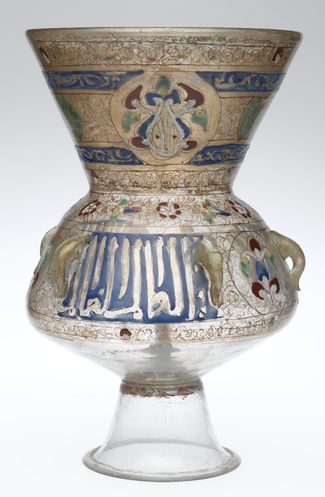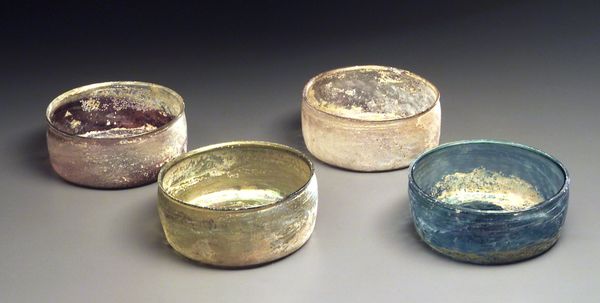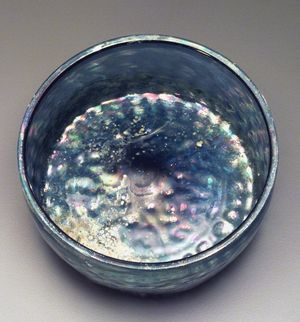Othoniel’s Sculptures and Glass from the Islamic World
Jean-Michel Othoniel: My Way just closed here in Brooklyn a few days ago, but The Secret Happy End (2008) is still on view in the first-floor lobby and we are always thinking of ways to draw connections between among our collections.
As Lisa mentioned, Othoniel’s work gives us a chance to explore the medium of glass across our diverse collections. While his work is unlike glass from the Islamic world in function and meaning, Othoniel has collaborated with workshops located in centers of glass production that hold particular importance to the medieval Islamic world. Beads in his glass sculptures were produced in Murano, Italy, home of the Venetian glass industry since the late 13th century. Trade between Venice and the Islamic world, including the transfer of glass objects and technology, has been extensively documented. The glass bricks that form Othoniel’s The Precious Stonewall (2010) were manufactured in Firozabad, India, a center of glass production since the 15th century that was founded by a Muslim ruler of the Delhi Sultanate.

Mosque Lamp. Egypt or Syria, 13th–14th century. Glass; free blown, applied, enameled, and gilded; tooled on the pontil. Bequest of William H. Herriman, 21.484.
Glassmaking technologies spread across the former Roman Empire, and some methods existed continuously into the Byzantine and early Islamic periods. Things we can sometimes see—a vessel’s shape, decoration, mold marks, imperfections, and pontil scars (left by a glassblowing tool)—can help us figure out how, and perhaps when or where, it was made. This excellent video produced by the Corning Museum of Glass demonstrates the process of free-blown glass, a basic technique used by glassmakers from antiquity to the present. Many of the glass beads and organic forms that make up Othoniel’s sculptures are also free-blown.
This mosque lamp, now on view on the second floor, is one of my favorite examples of a free-blown glass object in our Arts of the Islamic World collection for its enamel decoration. The Mamluk period (1250-1517 C.E.) in Egypt and Syria produced many fine examples of such glass lamps that were commissioned for mosques and charitable foundations. The illuminated glow of the lamp symbolized divine light, and mosque lamps were often inscribed with the well-known Sura of Light from the Qur’an. The inscription that encircles the body of the Brooklyn Museum example, however, repeats the phrase “the learned” in Arabic. Lamps of this type—characterized by a flared neck, a rounded body with handles, and a wide foot—hung from a mosque’s ceiling by chains. After the shape was set, enamel (made from finely crushed glass and an oily medium) was applied with a brush or reed pen, and the vessel was fired. The bottom of the Brooklyn Museum lamp was ground down and a flared pedestal was added at another point, but its intact wick is unusual among extant examples of Mamluk lamps.

Four Bowls. Iran, 11th–12th century. Glass; mold blown. Gift of The Roebling Society, 1991.41.1-.4
Aside from free blowing, another basic glassblowing technique involves blowing molten glass into a mold. These straight-sided round glass bowls in our Arts of the Islamic World collection date to the Saljuq period (1081-1307 C.E.) in Iran. While the four bowls are mold-blown, the transparent and aubergine (1994.41.1, above far left) and cobalt (1994.41.2, above far right and below) bowls were blown into a patterned mold to create a honeycomb pattern on the surface and bottom with a rosette in the center of the bowl.

Bowl. Iran, 11th–12th century. Glass; mold blown. Gift of The Roebling Society, 1991.41.2
The Romans had developed mold-blown glass centuries earlier, and the technique was employed across the Islamic world. These four bowls were probably formed from so-called full-size molds because it appears that their basic shape was not modified after removal from the mold. Molten glass on the end of a blowpipe was blown into a hinged full-size mold, so the pattern of the mold appeared in relief on the glass. The vessel was removed from the mold and finishing touches, such as a rim or handle, were added. The iridescent film now present on surface of these bowls is due to decomposition and previous burial. An acidic environment would cause the certain elements of the glass to undergo a chemical reaction in which the glass would separate into layers, forming a thick iridescent outermost layer subject to flaking.
Free- and mold-blowing are basic techniques for forming glass objects, and both are still in use across the globe today. Even though glass from the Islamic world and Othoniel’s glass sculptures hail from very different moments in time, they were made from the same material and with similar basic techniques.

Caitlin McKenna Thakral joined the Brooklyn Museum in 2011, and is now Research Associate of Islamic Art. She studied art history at Colgate University (BA) and the Institute of Fine Art Arts, New York University (MA). Before coming to Brooklyn, she was involved with museum projects and exhibitions at various institutions, including the Grey Art Gallery at NYU and the Guggenheim Museum. Her academic research on medieval Islamic architecture has been supported through travel abroad sponsored jointly by the Kunsthistorisches Institut in Florenz, Max-Planck-Institut, and the Getty Foundation. Her interests include working with content in all forms, taking field trips to grocery stores in foreign cities, and attempting Bollywood dance.
